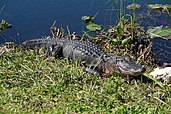Portal:Ecology/Selected article/8
Pictured left: An alligator in the Florida Everglades, the largest wetland system in the United States.
A wetland is an area of land whose soil is saturated with moisture either permanently or seasonally. Such areas may also be covered partially or completely by shallow pools of water. Wetlands include swamps, marshes, and bogs, among others. The water found in wetlands can be saltwater, freshwater, or brackish. The world's largest wetland is the Pantanal which straddles Brazil, Bolivia and Paraguay in South America. The study of wetlands has recently been termed paludology in some publications.
Wetlands are found on every continent except Antarctica, and are considered the most biologically diverse of all ecosystems. Plant life found in wetlands includes mangrove, water lilies, cattails, sedges, tamarack, black spruce, cypress, gum, and many others. Animal life includes many different amphibians, reptiles, birds, insects, and mammals. In many locations, such as the United Kingdom, Iraq, South Africa and the United States, wetlands are the subject of conservation efforts and Biodiversity Action Plans.
The UN Millennium Ecosystem Assessment determined that environmental degradation is more prominent within wetland systems than any other ecosystem on Earth. International conservation efforts and the development of rapid assessment tools are being used in conjunction with each other to inform people about wetland issues.
Wetlands also serve as natural wastewater purification systems—e.g., in Calcutta and Arcata. Many wetland systems possess biofilters, hydrophytes, and organisms that in addition to nutrient up-take abilities have the capacity to remove toxic substances that have come from pesticides, industrial discharges, and mining activities. The up-take occurs through most parts of the plant including the stems, roots, and leaves . Floating plants can absorb and filter heavy metals. Eichhornia crassipes (water hyacinth), Lemna (duckweed) and Azolla (water fern) store iron and copper commonly found in wastewater. Many fast-growing plants rooted in the soils of wetlands such as Typha (cattail) and Phragmites (reed) also aid in the role of heavy metal up-take. Animals such as the oyster can filter more than 200 liters (53 gallons) of water per day while grazing for food, removing nutrients, suspended sediments, and chemical contaminants in the process. (Full article...)

